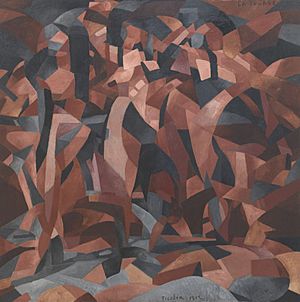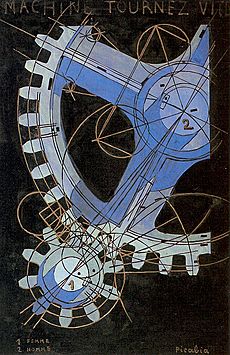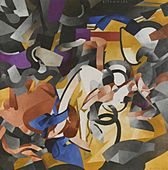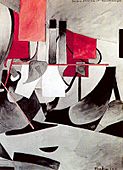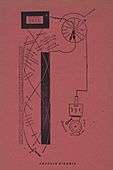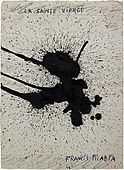Francis Picabia facts for kids
Quick facts for kids
Francis Picabia
|
|
|---|---|

Francis Picabia, 1919,
inside Danse de Saint-Guy |
|
| Born |
Francis-Marie Martinez Picabia
22 January 1879 Paris, France
|
| Died | 30 November 1953 (aged 74) Paris, France
|
| Known for | Painting |
|
Notable work
|
Amorous Parade |
| Movement | Cubism, Abstract art, Dada, Surrealism |
| Spouse(s) | Gabrièle Buffet-Picabia |
Francis Picabia (born Francis-Marie Martinez de Picabia; 22 January 1879 – 30 November 1953) was a French painter, poet, and designer. He was known for his "avant-garde" art, which means he created new and experimental styles.
Picabia explored many art movements. He started with Impressionism and Pointillism. Later, he became famous for his colorful and bold abstract paintings. He was a key figure in the Dada movement in the United States and France. He also briefly joined Surrealism before creating his own path.
Contents
About Francis Picabia
His Early Life
Francis Picabia was born in Paris, France. His mother was French, and his father was Cuban with Spanish roots. His family was wealthy.
Sadly, his mother died when he was seven years old. His grandmother also passed away soon after. Francis was then raised by his father.
From a young age, Picabia showed great artistic talent. When he was 15, he copied some Spanish paintings. He secretly swapped his copies for the real ones. Then he sold the originals to buy stamps for his collection!
His Art Journey
In the late 1890s, Picabia began studying art. He attended the École des Arts Decoratifs in Paris. Famous artists like Vincent van Gogh had also studied there.
For two years, he learned from teachers like Fernand Cormon. By the time he was 20, Picabia was earning a living from his paintings. He also inherited money, which made him financially independent.
Early Influences
From 1903 to 1908, Picabia painted in the style of Impressionism. He was inspired by artists like Alfred Sisley. His paintings showed everyday scenes. These included small churches, Paris rooftops, and riverbanks.
Some art critics said his work looked too much like other Impressionist painters. They felt he was not original enough.
Moving to Cubism
Around 1909, Picabia's style changed. He became interested in a new art movement called Cubism. Cubist artists broke objects into geometric shapes. They showed different angles of a subject at the same time.
Picabia joined a group of artists who would later be called the "Golden Section." In the same year, he married Gabrielle Buffet. They later divorced in 1930.
Around 1911, Picabia joined the Puteaux Group. He met many artists there, including Marcel Duchamp and Guillaume Apollinaire. This group helped shape his new artistic ideas.
The Dada Movement
Picabia was the only Cubist artist to attend the famous Armory Show in New York in 1913. This show introduced modern art to America. He even had his own exhibition there.
From 1913 to 1915, Picabia visited New York City several times. He played a big part in bringing new art ideas to America. During this time, France was involved in World War I.
In 1915, Picabia traveled to New York again. He was on his way to Cuba for a business trip. But he found New York City so interesting that he stayed longer.
During these years, Picabia created his "mechanical portraits." These artworks looked like machine parts. They were part of his early involvement with the Dada movement. Dada was an art movement that challenged traditional art. It often used humor and nonsense to express ideas.
Dada in Europe
In 1916, Picabia started his own Dada magazine called 391 in Barcelona, Spain. He continued publishing it with the help of Marcel Duchamp in the United States.
Later, Picabia met Tristan Tzara in Zurich, Switzerland. Tzara's radical ideas excited Picabia. Back in Paris, Picabia became a key figure in the Dada scene. He was known for being a "provocateur," someone who liked to stir things up.
Picabia stayed involved with Dada until 1921. Then he became interested in Surrealism. Surrealism was another art movement that explored dreams and the unconscious mind. He later criticized the Dada movement and its leader, André Breton.
In 1924, Picabia appeared in the surrealist film Entr'acte. He was shown firing a cannon from a rooftop! The film was an intermission for his avant-garde ballet, Relâche.
Later Years
In 1922, André Breton restarted his magazine Littérature. He gave Picabia complete freedom to design the covers. Picabia used religious images and symbols from games of chance.
In 1925, Picabia returned to painting in a more realistic style. In the 1930s, he became good friends with the writer Gertrude Stein.
In 1940, he married Olga Mohler. This was on the same day that the Nazis took over Paris during World War II. Soon after, he moved to the South of France.
After the war, he returned to Paris. He went back to painting abstract art and writing poetry. A large show of his work was held in Paris in 1949. Francis Picabia passed away in Paris in 1953. He is buried in the Montmartre Cemetery.
His Legacy
Picabia's artworks are held in major museums around the world. These include the Museum of Modern Art in New York and the Tate Gallery in London.
In 2016, a big exhibition of his work was held. It was called Francis Picabia: Our Heads Are Round so Our Thoughts Can Change Direction. It was shown at the Kunsthaus Zürich and the Museum of Modern Art in New York.
Many artists have been influenced by Picabia's unique style. These include American artists David Salle and Julian Schnabel.
Art Market
Picabia's paintings are very valuable. In 2003, one of his paintings sold for US$1.6 million. In 2013, his painting Volucelle II sold for US$8.789 million at an auction.
Gallery
-
Ici, c'est ici Stieglitz, foi et amour, cover of 291, 1915.
See also
 In Spanish: Francis Picabia para niños
In Spanish: Francis Picabia para niños
- Dadaglobe
- Anti-art


